BY: RICHIE ANDERSON
Before we learn how to train the golfer appropriately, the swing needs to be explored. My goal for this blog post would be to give you a general understanding of the golf swing and its demands.
THE GOLF SWING IS BROKEN DOWN IN THE RESEARCH INTO 5 GENERAL PARTS;
1. Takeaway
2. Backswing
3. Transition
4. Downswing
5. Follow-through
The golf swing uses these mechanics of the swing to create a rotational power base from ground reaction forces (GRF) that allow the golfer to create impact on the golf ball1. GRFs begin on the back leg and transfer to the lead leg in the downswing. The backswing is used to create a stretch of tissues and structures to capture and disperse energy through the club head.
Proper training will aid in efficiency of the kinetic sequence of the swing and over time improve club head speed and in turn, ball flight/distance. Proper biomechanics in golf are vital to successful swings and results1.
The backswing places the largest demand on the rotational abilities of the trunk2. Limited thoracic spine mobility can cause the backswing to be inefficient or incorrect, changing swing mechanics and performance2.
Professional Golfers have been shown in the research to have superior thoracic spine and pelvis rotation to that of amateur golfers (study considered amateurs to be a handicap of 5, and we all know most of us are shooting more than 5 over)1.
The transition phase begins near or at the longest “stretch” that that body can handle of counter rotation, and the downswing uses this counter rotation to unleash the club head towards the golf ball2. Pelvic rotation, hip internal rotation and strength through the trunk to transfer GRFs to the clubhead and with the follow-through of the swing.
THIS VIEW OF THE GOLF SWING ALLOWS US TO NOW KNOW WHAT THE DEMANDS PLACED ON THE BODY ARE, AS WELL AS DEFINED PHASES OF THE SWING THAT YOU CAN FOCUS ON IN YOUR TRAINING PROGRAM!
In summary, thoracic spine, pelvic rotation and hip internal rotation are going to be key elements to understand and determine what YOU need with your specific swing.
If you have any questions about the blog content, or would like to see what YOUR specific needs are to improve your golf game, please schedule an assessment!
FARRALLY MR, COCHRAN AJ, CREWS DJ, ET AL. GOLF SCIENCE RESEARCH AT THE BEGINNING OF THE TWENTY-FIRST CENTURY. J SPORTS SCI 2003, 21(7) 53-65.
HUME, P. A., KEOGH, J., & REID, D. (2005). THE ROLE OF BIOMECHANICS IN MAXIMISING DISTANCE AND ACCURACY OF GOLF SHOTS. SPORTS MEDICINE, 35(5), 429–449.

